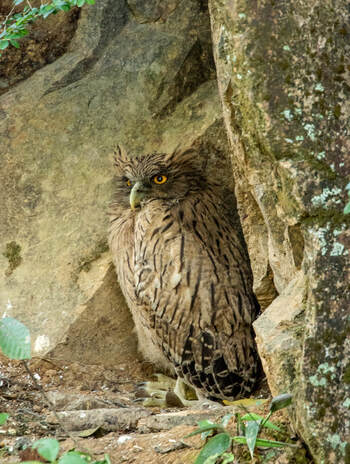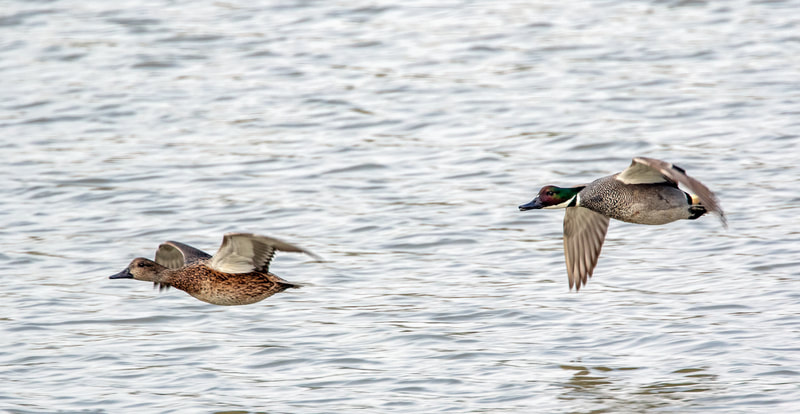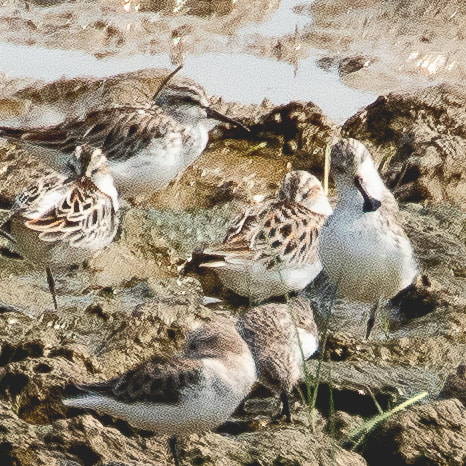385 species recorded There is not a strong emphasis on the Big Year in Hong Kong. The two cases I am aware of involve Richard Lewthwaite who saw 328 species in 1995 and Graham Talbot’s record of 350 species in 2006 - see Graham's account in HKBWS Bullletin number 207, Spring 2008 at: https://www.hkbws.org.hk/cms/en/resource/publication/bulletin?start=40 . I am not a great twitcher or lister. Even now, it surprises me that I began a Big Year in the first place and, perhaps more so, that I managed to see it through to the end of December. I certainly didn’t begin 2020 with a definite commitment to record as many birds in Hong Kong as I could during the year. I lead guided birding tours for foreign birders visiting or passing through Hong Kong. I had several bookings in January, which proceeded without a hitch but then in late January the coronavirus pandemic began and my guided birding outings came to an abrupt halt. Once the coronavirus interrupted our lives, I decided I needed a focus to keep me going during the year. A Big Year became a personal challenge and Graham’s tally of 350 seemed a good figure to aim for. Unsure of what the exact rules were (if there are any!), I decided to limit the birds I could count to species in Category I, IIA & IIB only. I included heard-only species, although tried to limit these as much as possible. I still ended up, somewhat unsatisfactorily, with five heard-only species but I console myself with the fact that they are all of birds I’ve seen previously in Hong Kong and they are all valid records in terms of the Hong Kong Bird Report. A full list of the 385 species can be found here. January I can't remember exactly when I decided to commit to the Big Year, but it must have been around 23 January when I twitched a female Fire-capped Tit at Kadoorie Farm. I had seen the first for Hong Kong in January 2019 – at the same site; in fact, in the same tree – and had also seen a few in Sichuan in summer 2019, so I would not normally have made the effort to see it again. However, it must have been on my mind that it was an excellent bird for the year list, and not to be passed up lightly. In terms of a Big Year in Hong Kong, January is the time when you’re going to record the greatest number of species for the list in a single month. Graham scored 181 in 2006; I managed 183. These naturally included a good spread of common resident and wintering species, but there were also some scarce/rare species – the kind of species which are the bread-and-butter of a Big Year if you’re going to come up with a respectable total. The autumn/winter of 2019 had been particularly good for rarities and some of these lingered into 2020. Thus, I got Chinese Grey Shrike, Rufous-faced Warbler and Kloss’s Leaf Warbler on the list, as well as other species – Northern Lapwing, Bull-headed Shrike, Asian House Martin, Forest Wagtail, White-spectacled Warbler, Mrs Gould’s Sunbird, Common Rosefinch and Crested Bunting – which although more-or-less annual, are not necessarily guaranteed. February I added 35 new species to the list in February; many of these were scarce birds that I realized I might not come across again in future months. Mai Po turned up Falcated Duck, Gadwall, Mallard and Greater Scaup– all ducks which used to be commoner than they now are. I also had Mew (Kamchatka) and Slaty-backed Gulls from the Mai Po boardwalk. Best, however, were wintering forest birds – Fujian Niltava at Lau Shui Heung, and Collared Owlet, Hill Blue Flycatcher and Chestnut-crowned Warbler at Tai Po Kau. It was Tai Lam Country Park, however, that came up trumps. I saw a female Small Niltava there on 6 February. Doing a Big Year inevitably brings days that linger in the memory; 17 February proved to be one of those days. On the trail from Kap Lung to Ho Pui in Tai Lam CP, near the narrow head of a forested stream known colloquially among birders as the “magic valley”, I saw Japanese Robin, Rufous-gorgeted Flycatcher and a roosting Collared Scops Owl, all in the same general area. I knew that the first two were wintering there, but the owl was a surprise; although common in Hong Kong, the species is easy to hear but not at all easy to see. Other good additions to the list in February included Radde’s Warbler, Black-headed Bunting and Red-headed Bunting at Long Valley, and a much-photographed Eyebrowed Thrush at Yuen Long Park. March to April
The good winter records extended into early March before spring migration properly began. On 2nd, from the Mai Po boardwalk, I relocated a Common Shelduck that had been seen flying over the main reserve on 26 February by John Allcock. This species was not on my hit-list. It used to be very common out in Deep Bay (highest count 4011 on 17 Jan 1988) but had undergone a rapid decline after the turn of the century; there had been no sightings since 2013. Other good sightings in early March included a flock of Grey-capped Greenfinches on the dam at Tai Mei Tuk, a Long-billed Dowitcher at Mai Po, and a party of Eurasian Siskins at Shek Kong. Spring migration commenced in the second part of the month. There are three key sites to cover at this time of the year for anyone doing a Big Year. The first, of course, is Mai Po which is a key site for all of the year but is essential in spring for passage shorebirds. The second place is Po Toi. The third is the waters south of Hong Kong for a number of migrant seabirds. To take each of these in turn, Mai Po turned up the expected spring waders including Asian Dowitcher, Sharp-tailed Sandpiper, Little Stint and Sanderling. One wader that birders always hope to see but one that is not guaranteed is the enigmatic Spoon-billed Sandpiper. Although still annual (just) at Mai Po in spring, it can be elusive; I had not seen it in 2019. Fortunately, this year was better than most; at least two birds were present between 7 & 13 April (for more details see https://www.birdinghongkong.com/april-2020.html), one of which was a headstarted bird. Many birders, myself included, were able to get decent views especially on the scrape at high tide. Other good birds at Mai Po included Chinese Egret, Blue-tailed Bee-eater and a male Japanese Paradise Flycatcher. The island of Po Toi is the best site to look for certain spring migrants that can be hard to find elsewhere in Hong Kong. Fortunately, the ferries continued to run to the island in spite of the coronavirus. I visited the island eleven times between and 19 March and 26 April. Highlights included Chinese Sparrowhawk, Oriental Cuckoo, Swinhoe’s Minivet, Chestnut-cheeked Starling, and a number of flycatchers (Blue-and-white, Ferruginous, Narcissus and Grey-streaked). Best, however, was a Goldcrest – a first for Hong Kong - that I was lucky enough to find on 31 March. Chartered boat trips into southern waters from Aberdeen are now a part of the ornithological calendar in Hong Kong. They are arranged by Carrie Ma and, although rather hit-and-miss in what they turn up, they are really the only means of seeing certain marine species in Hong Kong. I went on one trip in March, and two in April and managed to see eight species that I would not otherwise have seen. These were Greater Crested Tern, Common Tern, Aleutian Tern, Pomarine Skua, Parasitic Jaeger, Streaked Shearwater and Short-tailed Shearwater, all of which are regular in spring. A bonus on 30 April was a Brown Booby which flew past the boat as we were heading back to Aberdeen. This was the 13th record for the territory, and a Hong Kong first for me. I had other good birds in spring away from these main sites. At the end of March, the ridge road in Tai Lam CP that leads from Route Twisk to Tai Lam Reservoir is a potential site for raptors and needletail swifts. On 27 March, I was fortunate enough to connect with two Silver-backed Needletails there. In addition, I found a Common Swift at Long Valley on 3 April and watched it feeding low over one of the ponds for half an hour. I also found a Glossy Ibis at Lut Chau on 9 April. I also made a concerted effort to connect with Chinese Grassbird this year, a species I hadn’t seen for a few years in spite of searching for it in suitable habitat at Tai Mo Shan. This year I tried a different tack and on 18 April walked up the steepish steps to Ping Fung Shan from Hok Tau. Richard Lewthwaite had had this species as well as Upland Pipit here in May 2017 during a breeding survey. I found both species and had good views of a pair of Chinese Grassbirds, as well as another bird on territory. I heard Upland Pipit singing high up on a hillside but unfortunately failed to see it. I was also rewarded with two White-throated Needletails whooshing low over my head. I added 43 species in March and 49 in April, which left me with a total of 310 species. This was 80.5% of my overall total of 385.
0 Comments
Leave a Reply. |

























 RSS Feed
RSS Feed
